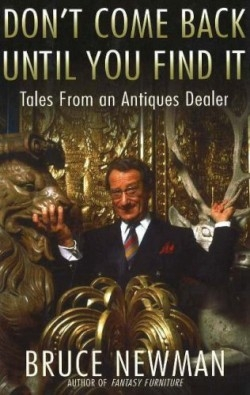Don't Come Back Until You Find It
Tales from an Antiques Dealer
Just as every retailer employs the soft-sell art of window dressing—placing an enticing item to beckon the customer within—this author opens his charmingly earnest and flawless memoir with this true story:
When Jackie Kennedy began refurbishing the presidential living quarters (thus inaugurating and promulgating her own modern interior design tastes), she sought out Newman’s well-known Newell Gallery in New York. On her shopping list was a chest of drawers for the Lincoln Bedroom, a request for which she was both visionary and specific. Many photographs and letters later (her handwritten notes are reproduced here), neither Newman nor his colleagues found anything to pass muster. Then, in the window of a now-defunct thrift shop in mid-town, he spied a dusty candidate, and for $90 it was accepted.
Cut to the Clinton years, when the chest stands as a modest prop to the bedroom’s $1,000-a-night celebrity guests. Ironic, considering how Newman’s father built their company by renting stage furniture to Broadway shows. The author also finds it “a small betrayal of a sense of style Jackie had tried to bring to the White House,” ruing its role in image making. This sentiment distinguishes Newman’s from other sell-all stories of celebrity clients; his discernment and dignity in sensing the harmony between customers and their treasures makes his tour of the shop spirited and enlightening.
Stalking elusive fabled treasure is a hunter’s game, and Newman appreciates the risk it entails. His ultimate coup—tracking down the pristine 1930s murals of the French luxury ocean liner Normandie—begins in a dank Parisian warehouse and ends when he secures the trophy for his client, who later bequeaths it to Pittsburgh’s Carnegie Museum of Art.
Capping his fifty-year career was the prestigious 1989 sell-out exhibit at the National Academy of Design of Newman’s lifelong collection of “fantasy furniture,” prizes of decorative art to stagger the eye: bears attached to table legs or rearing up behind chairs, Gothic gargoyles, Chinese dragons, chandeliers made of antlers. That exhibit, at the Fifth Avenue Beaux-Arts building, was also an ironic bookend to his father’s immigrant industry. Their business began with a horse-drawn wagon along Fifth and Park Avenues during the Depression, harvesting cumbersome furniture left on the curb for garbage. Such is a circle of culture and commerce, one man’s family story of rags to riches.
Novice buyers are not ignored in Newman’s world; he appends a careful list of how to buy and assess antiques, how to spot a reproduction. Gracious in seeing his own era ebb, the author exhibits a lifetime’s appreciation of manual workmanship, which makes his company well rewarding. For additional celebrity tattle, he’s courteous to all who walk through his doors, though it’s safe to say that furniture-designer Viscount David Linley, nephew to Queen Elizabeth, will not be welcomed (due to a near-suing episode over the Fantasy Furniture copyright).
The title was the thundering law his father laid down when Newman failed to purchase nails he’d been sent out to buy. Wisdom not wasted on his son.
Reviewed by
Leeta Taylor
Disclosure: This article is not an endorsement, but a review. The publisher of this book provided free copies of the book to have their book reviewed by a professional reviewer. No fee was paid by the publisher for this review. Foreword Reviews only recommends books that we love. Foreword Magazine, Inc. is disclosing this in accordance with the Federal Trade Commission’s 16 CFR, Part 255.

